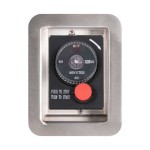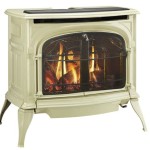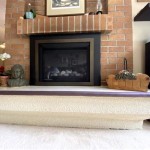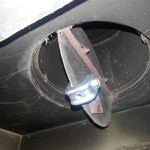Fireplace Brick Cleaning: A Comprehensive Guide
Fireplaces offer warmth and ambiance to a home, particularly during colder months. However, the accumulation of soot, creosote, and ash from burning wood can leave fireplace bricks looking dull and unattractive. Regular cleaning is essential to maintain the aesthetic appeal of the fireplace and potentially mitigate fire hazards associated with creosote buildup. This article provides a detailed guide on how to effectively clean fireplace bricks, covering various methods and necessary precautions.
The frequency of cleaning depends on how often the fireplace is used. If the fireplace is used regularly throughout the winter, cleaning should be conducted at least once a year. For fireplaces used less frequently, cleaning every two to three years is generally sufficient. Neglecting fireplace brick cleaning can lead to stubborn stains that are more difficult to remove, and in the case of creosote, increase the risk of chimney fires.
Before undertaking any cleaning method, it's crucial to prioritize safety. Ensure the fireplace is completely cool before commencing any cleaning activity. Gather necessary protective gear, including gloves, safety glasses, and a dust mask or respirator, to prevent inhalation of dust and exposure to cleaning solutions. Protect the surrounding area by laying down drop cloths or old sheets to prevent spills and stains on flooring or furniture.
Preparing the Fireplace for Cleaning
Preparation is a critical first step in effectively cleaning fireplace bricks. This stage involves removing loose debris and protecting the surrounding areas from cleaning solutions and dislodged soot.
First, remove all ash and unburnt wood from the fireplace. Use a shovel and sturdy container to dispose of the debris properly. A metal bucket is recommended for ash, as it reduces the risk of accidental fires. Ensure the container is placed away from flammable materials.
Next, use a stiff-bristled brush or a shop vacuum to remove loose soot and debris from the brick surfaces. Pay close attention to crevices and corners where soot tends to accumulate. A wire brush can be used for particularly stubborn areas, but caution is advised to avoid scratching the brick surface. Gentle scrubbing is preferable to aggressive scrubbing, especially on older or more delicate bricks.
Once the loose debris has been removed, protect the surrounding floor and walls. Lay down drop cloths or old sheets to prevent staining or damage from cleaning solutions. Tape the edges of the drop cloths to ensure they stay in place and provide adequate coverage. This step is crucial, as some cleaning solutions can be corrosive or cause discoloration to surfaces.
Good ventilation is also important. Open windows and doors to provide adequate airflow and minimize the inhalation of fumes from cleaning solutions. If possible, use a fan to circulate the air and direct fumes away from the work area.
Cleaning Methods for Fireplace Bricks
Several methods can be employed to clean fireplace bricks, each with its own advantages and disadvantages. The choice of method depends on the severity of the staining, the type of brick, and the availability of cleaning supplies.
Dish Soap and Water: A simple and often effective method for removing light soot and grime involves using dish soap and water. Mix a few drops of dish soap in a bucket of warm water. Using a sponge or scrub brush, apply the soapy water to the brick surfaces and scrub gently. Rinse thoroughly with clean water and allow the bricks to dry completely. This method is suitable for regular maintenance and light cleaning.
Vinegar and Water: Vinegar is a natural cleaning agent that can help remove stubborn stains and odors. Mix equal parts white vinegar and water in a spray bottle. Spray the solution onto the brick surfaces and let it sit for a few minutes. Scrub with a brush or sponge, then rinse thoroughly with clean water. Vinegar can be particularly effective in removing smoke odors and light creosote buildup. It is important to test this solution on an inconspicuous area first, as vinegar can etch some types of brick.
Baking Soda Paste: Baking soda is a mild abrasive that can help remove tough stains without damaging the brick. Create a paste by mixing baking soda with a small amount of water. Apply the paste to the stained areas and let it sit for several hours or overnight. Scrub the paste with a brush or sponge, then rinse thoroughly with clean water. Baking soda is effective in removing soot stains and can also help neutralize odors.
Commercial Brick Cleaners: Several commercial brick cleaners are available on the market. These cleaners are specifically formulated to remove soot, creosote, and other stains from brick surfaces. Always follow the manufacturer's instructions carefully when using commercial cleaners. Wear appropriate protective gear, including gloves and safety glasses, and ensure adequate ventilation. Test the cleaner on an inconspicuous area first to ensure it does not damage or discolor the brick.
TSP (Trisodium Phosphate): TSP is a powerful cleaning agent that can effectively remove heavy soot and creosote buildup. However, TSP is a strong chemical and should be used with caution. Wear gloves, safety glasses, and a respirator when using TSP. Mix TSP with water according to the manufacturer's instructions. Apply the solution to the brick surfaces and let it sit for a few minutes. Scrub with a brush or sponge, then rinse thoroughly with clean water. TSP can be harmful to the environment, so dispose of wastewater properly and avoid contact with skin and eyes. Due to environmental concerns, TSP is banned or restricted in some areas, so check local regulations before using it.
Muriatic Acid: Muriatic acid is a very strong acid and should only be used as a last resort for extremely stubborn stains. It is highly corrosive and requires extreme caution. Only experienced individuals should use muriatic acid, and proper protective gear, including a respirator, acid-resistant gloves, and safety glasses, is essential. Dilute the muriatic acid with water according to the manufacturer's instructions. Apply the solution to the brick surfaces and let it sit for only a few minutes. Scrub with a brush, then rinse thoroughly with clean water. Muriatic acid can etch or damage certain types of brick, so testing on an inconspicuous area is crucial. It is also important to neutralize the acid after cleaning with a solution of baking soda and water. Proper disposal is critical. Consult local regulations for the safe and legal disposal of muriatic acid waste. This option is best left to professionals.
Specific Techniques for Difficult Stains
In some cases, certain stains may require specific techniques and cleaning solutions to effectively remove them. Identifying the type of stain and selecting the appropriate cleaning method are crucial for achieving optimal results.
Creosote Removal: Creosote is a tar-like substance that accumulates in chimneys and fireplaces as a byproduct of burning wood. It is highly flammable and can pose a significant fire hazard. If creosote buildup is significant, it is recommended to hire a professional chimney sweep to clean the chimney and fireplace. For lighter creosote deposits on the brick surfaces, a commercial creosote remover can be used. Follow the manufacturer's instructions carefully and wear appropriate protective gear. Alternatively, a mixture of TSP and water can be used, but caution is advised due to the chemical's strength. Scrub the affected areas thoroughly and rinse with clean water.
Rust Stains: Rust stains can occur on fireplace bricks due to moisture and metal components. To remove rust stains, try using a paste made of lemon juice and salt. Apply the paste to the stained areas and let it sit for several hours. Scrub with a brush or sponge, then rinse thoroughly with clean water. Alternatively, a commercial rust remover can be used, following the manufacturer's instructions. Be careful not to damage the brick surface while scrubbing.
Efflorescence Removal: Efflorescence is a white, powdery deposit that can appear on brick surfaces due to moisture and soluble salts. To remove efflorescence, use a stiff-bristled brush to dry-brush the affected areas. Then, mix equal parts white vinegar and water and apply the solution to the brick surfaces. Let it sit for a few minutes, then scrub with a brush or sponge. Rinse thoroughly with clean water. For stubborn efflorescence, a commercial efflorescence remover may be necessary.
Smoke Odor Removal: Even after cleaning the bricks, a lingering smoke odor may persist. To remove smoke odors, try placing a bowl of vinegar or baking soda in the fireplace for several days. These substances will help absorb the odors. Alternatively, a commercial odor eliminator specifically designed for smoke odors can be used. Ensure the product is safe for use on brick surfaces.
After applying any cleaning solution, thorough rinsing with clean water is crucial. Residue from cleaning agents can attract dirt and grime, potentially leading to future staining. Use a sponge or cloth to wipe down the brick surfaces, ensuring all traces of the cleaning solution are removed. Multiple rinses may be necessary to completely eliminate residue.
Once the bricks have been thoroughly rinsed, allow them to air dry completely. This may take several hours or even overnight, depending on the humidity and ventilation. Ensure the fireplace is completely dry before using it again. Applying a sealant can help protect the bricks from future staining and make cleaning easier. Choose a sealant specifically designed for brick surfaces and follow the manufacturer's instructions carefully.

How To Clean A Fireplace Diy Basics

How To Clean Fireplace Bricks 9 Steps With S Wikihow

How To Clean Brick Fireplaces Mantels Hearths And More My Space

How To Clean Brick Fireplace Royal Stone Care

Best Way To Clean A Fireplace Stacy Risenmay

How To Clean Fireplace Bricks 9 Steps With S Wikihow

Paint N L Fireplace Cleaner Chimneysaver

Mortar Wash Brick Fireplace Makeover Dimples And Tangles

How To Clean A Sooty Fireplace With Household Items Brick House Cleaning Tips

Fixr Com Brick Vs Stone Fireplace Pros Cons Comparisons And Costs








